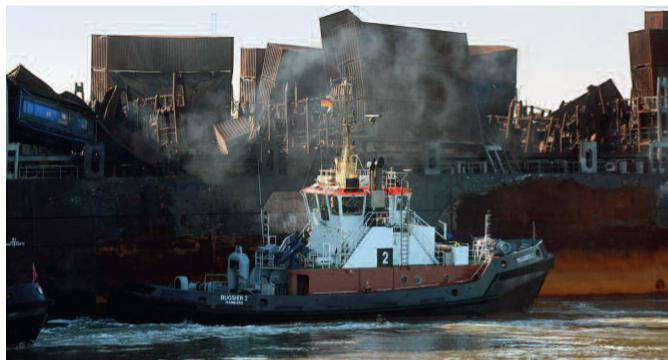Case study
The judgment in ‘MSC Flaminia’ 116 found that extensive information available concerning the stability of the commodity was ignored and not disclosed to the carrier. The judge found that, “Disaster was a foreseeable result”.
-
116 In re M/V MSC Flaminia No.12-cv-8892 (KBF) www.leagle.com/decision/infdco20180911a96 Originally published as TT Talk “Legal eagle: the consequences of foreseeability” on 15 January 2019.
Many will be aware of the essential facts behind this incident aboard ‘MSC Flaminia’. In mid- July 2012, the ship was crossing the Atlantic from the United States bound for Antwerp, Belgium, having left New Orleans, Louisiana some fourteen days earlier, laden with containerised cargo.
Alarms began sounding early on the morning of 14 July, alerting the crew to a smoky cloud rising from one of the cargo holds. Firefighting procedures were initiated, but an explosion cost the lives of three crewmembers and the fire continued to burn for a number of weeks whilst the ship remained at sea.
In an earlier part of the complex and protracted proceedings, the Court had determined that the explosion was the result of runaway auto-polymerization of cargo consisting of divinylbenzene (DVB), stowed in the hold. Having reached a conclusion on the causation, the court set out to establish the responsibilities between the parties remaining in the proceedings, being essentially the owner, manager and operator interests in the ship itself, the shipper of the DVB, and both the freight forwarder and NVOC involved.
A case note of this nature can hardly do justice to the range of arguments and counter-arguments raised between the parties; the judgment is recommended reading, providing detailed analysis of the facts, logistics industry processes, and the interface of mandatory regulations and contractual terms. Most important, however, is the clear application of the law.
Relying heavily on the decision in ‘DG Harmony’117, the judge stated the breach of the duty of care “may arise both from a failure to conform with regulatory requirements, or with standard industry or reasonable practice”, neatly balancing the interface of obligations under regulation and general negligence. As a consequence, it was found reasonable for the carrier to assume that the cargo was “manufactured and had been delivered in a manner that would allow it to arrive safely at an overseas destination under normal voyage conditions”; there was no expectation, absent additional warning, that the carrier be aware of “dangers greater than those detailed in the International Maritime Dangerous Goods (IMDG) Code”. By extension, a shipper has a duty to “warn the carrier of dangers posed by the cargo”. Importantly, the judge concluded that there is “nothing in the IMDG Code [stating] that a shipper and NVOCC may not provide additional information”.

While the commodity was, at the time of the shipment, correctly classified as Class 9, UN 3082118, this was a generic listing that, absent more specific information, denoted that the goods did not present dangers covered by any of the other classes. However, the circumstances were found to be other than “normal, reasonably anticipated conditions” in that, contrary to the shipper’s own internal protocols, the shipment was authorised to be loaded in a hotter location, with no additional measures, such as specific temperature monitoring or carriage in refrigerated containers.
These factors were compounded by the NVOC with deficient system infrastructure, on which there was misguided reliance, and poor training together with a misunderstanding that industry practice sees the Dangerous Goods Declaration (DG D) as the “primary source of safe handling information for dangerous goods”, rather than the Safety Data Sheet that may typically accompany the bill of lading/carriage document. Critically, the DGD needs to contain sufficient information to warn the carrier and permit appropriate actions, including stowage decisions.
-
117 On 9 November 1998, the M/V DG HARMONY caught fire off the coast of Brazil following an explosion in its third hold. The fire rendered the ship and its cargo a constructive total loss.
The court found that the shipper failed to take account of the nature of the cargo and specific circumstances of this shipment. The NVOC failed to act on the extensive information available from the shipper and specifically, did not disclose key information about the cargo to the carrier. Following this reasoning, both the shipper and NVOC were found strictly liable under US Carriage of Goods by Sea Act (COGSA), because while the carrier was aware of the generic dangers posed by the cargo, it did not have “sufficient and relevant information” (and hence no responsibility) for the specific additional hazards presented.
The judge went further to analyse the bill of lading terms, finding specific obligations in relation to dangerous goods and a full indemnity (including “all reasonable legal expenses and costs”) in favour of the carrier.
This case may be rare in that the shipper and NVOC were substantial US resident entities. Not only did the evidence build sufficiently to pin liability to them, but there were none of the common pitfalls concerning enforcement of the judgment (once quantum has been determined).
The MSC Flaminia case remains, at the date of publication of this guide, under appeal.

Utilising the bill of lading provisions was particularly favourable to the carrier since it presents the potential (in the US) to recover beyond the scope of COGSA alone.

-
118 Classification for DVB was subsequently changed in Amendment 38-16 to Class 4.1 (Flammable solids, self-reactive substances, solid desensitized explosives and polymerizing substances), UN 3532



